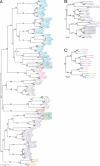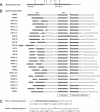Genomic analysis of the nuclear receptor family: new insights into structure, regulation, and evolution from the rat genome
- PMID: 15059999
- PMCID: PMC383302
- DOI: 10.1101/gr.2160004
Genomic analysis of the nuclear receptor family: new insights into structure, regulation, and evolution from the rat genome
Abstract
Completion of the Rattus norvegicus genome sequence enabled a global inventory and analysis of the nuclear receptors (NRs) in three mammalian species. Forty-nine NR members were found in mouse, 48 in human. Forty-seven were found in the rat, with gaps at the locations expected for the other two. Pairwise comparisons of their distribution in rat, mouse, and human identified 11 syntenic NR gene blocks, including three small clusters of two or three closely related genes, each spanning 40 kb to 1700 kb. The exon structure of the ligand-binding domain suggests that exon shuffling has played a role in the evolution of this family. An invariant splice junction in all members of the NR family except LXRbeta suggests a functional role for the intron. The ligand-binding domains of PXR and CAR are among the most divergent in the family. Their higher nucleotide substitution rates may be related to the central role played by these two NRs in the metabolism of the foreign compounds and may have resulted from limited positive selection.
Figures





Similar articles
-
Genome inventory and analysis of nuclear hormone receptors in Tetraodon nigroviridis.J Biosci. 2007 Jan;32(1):43-50. doi: 10.1007/s12038-007-0005-4. J Biosci. 2007. PMID: 17426379
-
International Union of Pharmacology. LXV. The pharmacology and classification of the nuclear receptor superfamily: glucocorticoid, mineralocorticoid, progesterone, and androgen receptors.Pharmacol Rev. 2006 Dec;58(4):782-97. doi: 10.1124/pr.58.4.9. Pharmacol Rev. 2006. PMID: 17132855 Review. No abstract available.
-
Compound profiling using a panel of steroid hormone receptor cell-based assays.J Biomol Screen. 2008 Sep;13(8):755-65. doi: 10.1177/1087057108322155. Epub 2008 Aug 27. J Biomol Screen. 2008. PMID: 18753690
-
The androgen receptor (AR) amino-terminus imposes androgen-specific regulation of AR gene expression via an exonic enhancer.Endocrinology. 2001 Mar;142(3):1107-16. doi: 10.1210/endo.142.3.8049. Endocrinology. 2001. PMID: 11181525
-
Non-canonical dimerization of the androgen receptor and other nuclear receptors: implications for human disease.Endocr Relat Cancer. 2019 Aug;26(8):R479-R497. doi: 10.1530/ERC-19-0132. Endocr Relat Cancer. 2019. PMID: 31252411 Review.
Cited by
-
Molecular adaptation and resilience of the insect's nuclear receptor USP.BMC Evol Biol. 2012 Oct 5;12:199. doi: 10.1186/1471-2148-12-199. BMC Evol Biol. 2012. PMID: 23039844 Free PMC article.
-
Research resource: Tissue-specific transcriptomics and cistromics of nuclear receptor signaling: a web research resource.Mol Endocrinol. 2010 Oct;24(10):2065-9. doi: 10.1210/me.2010-0216. Epub 2010 Aug 4. Mol Endocrinol. 2010. PMID: 20685849 Free PMC article.
-
The evolution of drug-activated nuclear receptors: one ancestral gene diverged into two xenosensor genes in mammals.Nucl Recept. 2004 Oct 12;2(1):7. doi: 10.1186/1478-1336-2-7. Nucl Recept. 2004. PMID: 15479477 Free PMC article.
-
Single-Nucleotide Variations of the Human Nuclear Hormone Receptor Genes in 60,000 Individuals.J Endocr Soc. 2017 Dec 4;2(1):77-90. doi: 10.1210/js.2017-00406. eCollection 2018 Jan 1. J Endocr Soc. 2017. PMID: 29379896 Free PMC article.
-
Ligand unbinding pathways from the vitamin D receptor studied by molecular dynamics simulations.Eur Biophys J. 2009 Feb;38(2):185-98. doi: 10.1007/s00249-008-0369-x. Epub 2008 Oct 3. Eur Biophys J. 2009. PMID: 18836710
References
-
- Adams, M.D., Celniker, S.E., Holt, R.A., Evans, C.A., Gocayne, J.D., Amanatides, P.G., Scherer, S.E., Li, P.W., Hoskins, R.A., Galle, R.F., et al. 2000. The genome sequence of Drosophila melanogaster. Science 287: 2185-2195. - PubMed
-
- Bailey, J.A., Gu, Z., Clark, R.A., Reinert, K., Samonte, R.V., Schwartz, S., Adams, M.D., Myers, E.W., Li, P.W., and Eichler, E.E. 2002. Recent segmental duplications in the human genome. Science 297: 1003-1007. - PubMed
WEB SITE REFERENCES
-
- http://genome.ucsc.edu/; UCSC genome bioinformatics.
-
- http://blocks.fhcrc.org/; blocks WWW server.
Publication types
MeSH terms
Substances
Grants and funding
LinkOut - more resources
Full Text Sources
Other Literature Sources
Molecular Biology Databases
